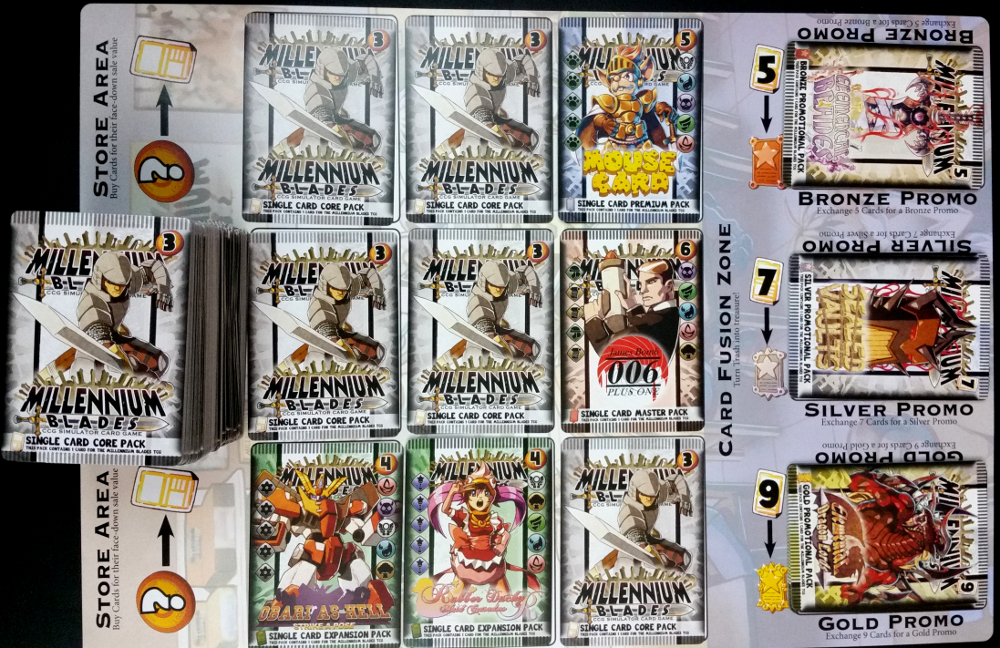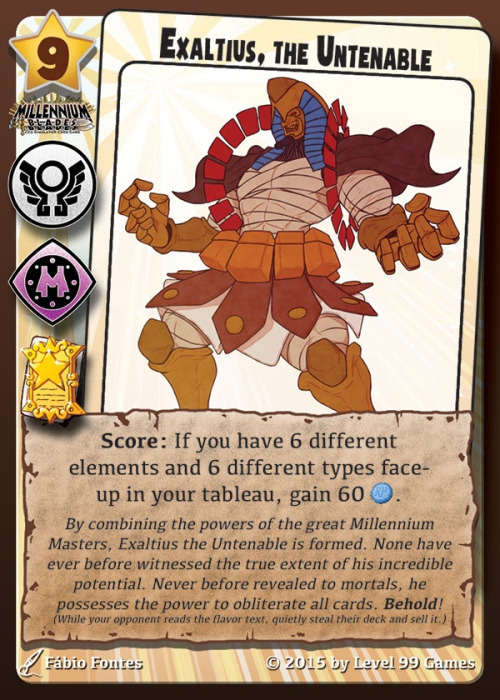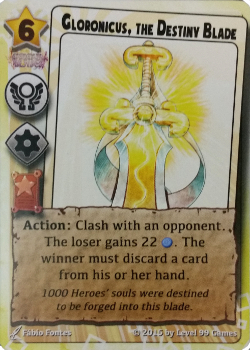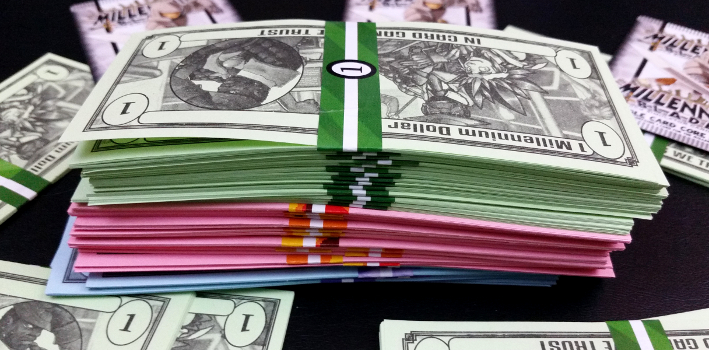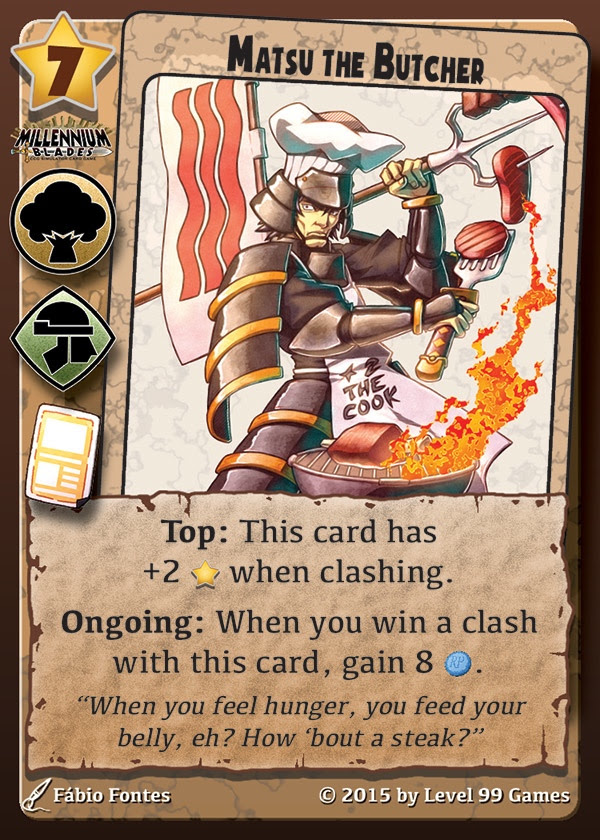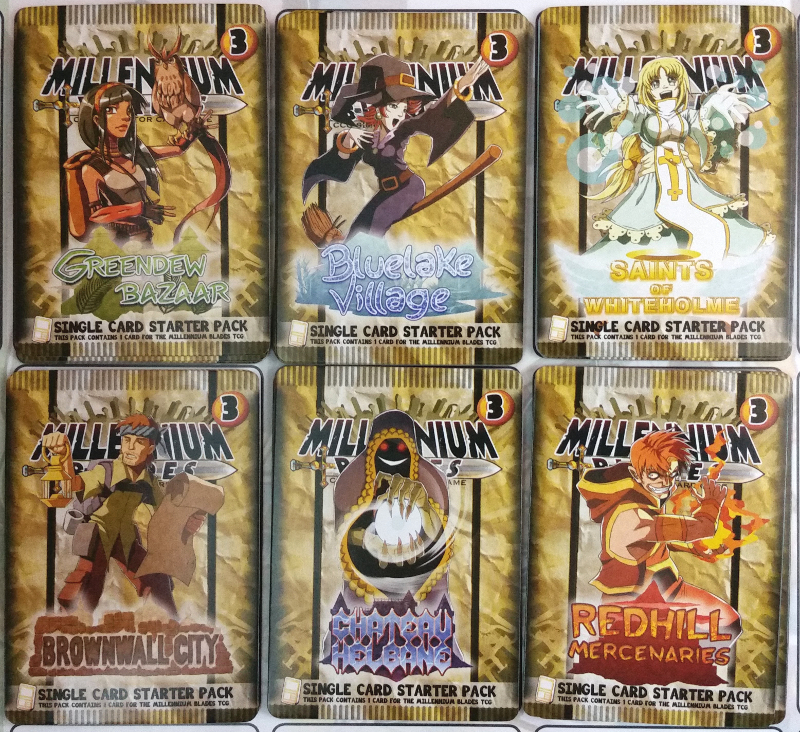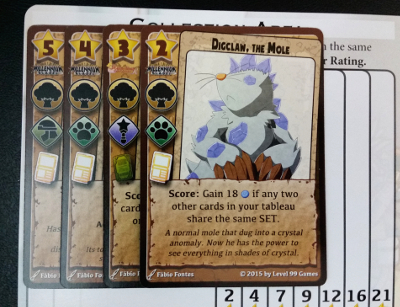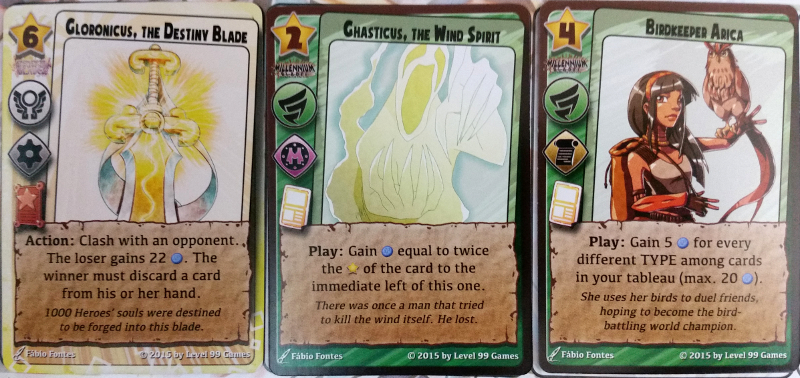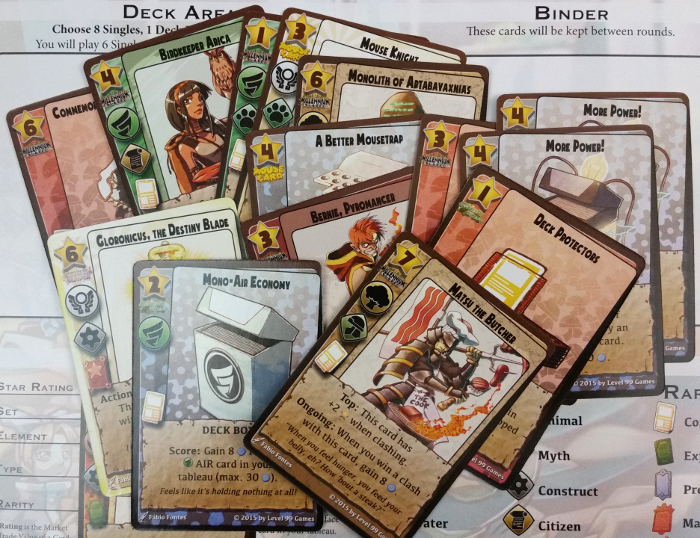Zak was completely flummoxed. Little beads of sweat had begun trickling down the back of his neck, partially because of the bright lights at the world championship table, and partially because he was mentally straining to find a way out his predicament. It was win or go home. He was on the ropes, and by the way that his opponent continued to feign disinterest in the situation, she knew it too. He was proud of how far he had come with a simple clockwork deck of quirky robots, but now, in the final round, it was failing him in dramatic style. Zak was being outflanked at every turn by a deck, which seemingly revolved around a weird mix of plumbers and space princesses.
He only had one long shot chance to secure victory. Slowly drawing what was to be his final card – one way or the other – Zak paused before flashing a wide grin…
The Premise
On a world not unlike Earth, the massively expansive collectible card game Millennium Blades has been played for centuries. In a recreation of that setting, players strive for fame and glory by amassing valuable card collections and crafting powerful decks, all in the hopes of becoming world class tournament champions.
The Rules
Millennium Blades is an expansive card game that requires significant table space. Setup is lengthy, including the use of 20 different card decks, so players should consult the rule book for full details.
To begin, each player receives a player board, a unique starting deck, three cards from a combined Store deck, and a Character card which gives the player a pair of special abilities.
Millennium Blades is broken down into three rounds, each of which has a Deckbuilding Phase and a Tournament Phase. The Deckbuilding Phase is a real-time Simultaneous Action process and it takes place over exactly 20 minutes. Before each Deckbuilding Phase, players receive $30 and six free cards from the Store. The Store is then populated with cards that players can buy.
Once the timer begins, players take any number of actions as often as they choose, including buying random cards from the Store, buying or selling cards in the Aftermarket, making trades with other players, or exchanging (aka Fusing) cards from their inventory to take a random card from one of three Promo decks.
Players may also form a Collection by setting aside a series of cards to exchange for VP at the end of Deckbuilding. Most importantly, players allocate cards to their tournament deck. Deckbuilding is paused twice periodically to give players more free cards and signal the end of their ability to buy cards, but it essentially proceeds as a free-for-all until the Tournament Phase begins.
After 20 minutes of Deckbuilding, all players need to have assembled their deck for the Tournament. These decks consist of eight cards, plus a few bonus deck boxes and/or accessories.
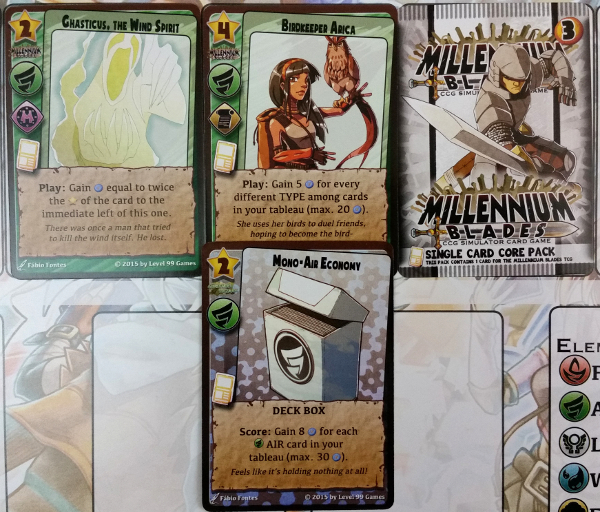
The Deck Box gives 16 RP for these two Air cards during scoring. The third face down Air card doesn’t count.
In the Tournament Phase, players take turns playing cards to their board. Most perform an effect when played, when flipped face down, when in certain locations on the board, or when used during scoring at the end of the tournament. Some cards also have an Action keyword; these are one-time effects that can be used before or after playing a card. The idea is to create powerful combinations.
The goal in the Tournament Phase is to generate as many Ranking Points (RP) as possible. Once everyone has played six cards, the tournament is over. Players add up their RP and are awarded VP based on their ranking. Then a new round begins.
At the end of the third round, the game ends. After some minor endgame scoring, the person with the most VP will go on to claim the title of Millennium Blades World Champion and all the perks that go with it.
Everyone else should just wait for the sets to rotate before trying again in the big leagues.
This Is Just A Tribute
By their nature, CCGs continuously release new sets and content as a way of drawing in new players and keeping the game fresh for existing players. To this genre of game, the status quo isn’t just unacceptable – it’s a death knell. It’s only fitting that Millennium Blades embodies at least some of the positive and negative sides of this constantly changing behavior.
The single greatest attribute is that despite the number of options available, the game does a surprisingly good job minimizing potential Analysis Paralysis. The real-time 20 minute Deckbuilding phases, which force you to make calculated and meaningful decisions quickly, definitely help to this end. By simulating the constantly-changing ecosystem of a CCG setting, the game doesn’t give players the chance to spend long minutes agonizing over decisions. It also helps maintain the game’s ability to easily scale with player size.
This effort is reinforced during the Deckbuilding phase by capping the number of cards you can sell or fuse each round. Although it isn’t thematic, curtailing the number of cards you can sell stops deck creation from becoming an endless cycle of min-maxing.
By contrast, the game’s negative aspects are limited. Just like an actual CCG, the biggest obstacle to Millennium Blades is the pre-game prep. For starters, before your very first game you’ll need to assemble the money stacks – a task that is equal parts tedious and time-consuming. The payoff for this effort is the game’s colorful cash stacks which are tossed about when buying and selling cards. These bundles may not be the most efficient means of tracking finances, but they add to the game’s thematic experience. By using physical money, Millennium Blades engrosses you in the tactile (and sometimes even painful) psychological experience of shelling out money for desired cards.
The other pre-game hindrance the game’s extensive set of options and how much time that adds to setup. Every playthrough includes a dozen different card decks that get added to the Store, and the game could have benefitted with ‘randomizer’ cards to help that process.
The tradeoff is that each set provides their own gameplay style and flavor. This can make for a sometimes-overwhelming amount of variety. From westerns to video game spoofs to classic anime tropes, the game’s cards are wide-ranging both mechanically and visually. So not only is every play session guaranteed to be unique, but it’s left to the players to discover which card combinations work best. What happens when you combine creepy gnomes with samurai or space cowboys with shamanistic druids? There’s only one way to find out. Many players (Daredevils especially) should be quite pleased with the level of deck experimentation that exists in this game.
A Faithful Adaptation
A bewildering part to any collectible card game is that, by their nature, they vary wildly in how they’re enjoyed by players. Some like building decks and competing in tournaments, others enjoy amassing personal collections, or cracking open random packs to see what’s inside. And everyone must contend with the volatile secondary market where desirable cards are routinely bought and sold. Therefore, to bill itself as a complete CCG simulation in a box, Millennium Blades had to blend all of these different preferences together in a cohesive way.
Impressively, it mostly accomplishes that goal, largely thanks to a number of clever mechanical constraints, the game approximates a CCG while still being manageable. It does this in part by removing the largest obstacle from the equation – the need for a fully customizable deck.
From the variation in card sets each playthrough to the way you acquire and ditch cards, the Deckbuilding phase of the game lets you hone your tournament deck without getting overwhelmed by the prospect of assembling a full deck. Instead, Millennium Blades pares the concept down into sculpting a hand of 8-11 cards, making it more a game of optimal hand management. Likewise, tournaments are focused on maximizing RP gains over defeating your opponents in lengthy combat. This hand building approach makes the game highly robust without it becoming mired in too many options.
Moreover, by not focusing on the deck creation side of CCGs, Millennium Blades avoids having the winner boil down to who won the tournaments. Placing well is the primary method of getting VP, but it’s neither the only focus of the game nor the only path to victory.
It’s possible, with a little luck, to reap extensive VP by trading in high-valued Collections or cornering the market with well-timed sales. Or all of the above. By embracing a more holistic approach to the CCG world, Millennium Blades strengthens its premise while broadening its appeal to a wider audience of potential cardmasters, including Architects.
Millennium Blades, then, is obviously not a completely authentic CCG simulation – and it should be lauded for that. Rather, it’s an adaptation that retains most of what makes collectible card games entertaining while stripping out the areas that aren’t. The result is an immersive and thematic experience, from the highly visible tournament scene down to the feeling of spending money on a random card that turns out completely useless. Through numerous disparate set styles, Millennium Blades creates the notion of a game with a lengthy and storied history to explore. For Immersionists, this game isn’t a matter of whether they’ll like it, but which portion of it they’ll like the best.
The CCG Game For Non-CCG Gamers
One of Millennium Blades best and most surprising attributes, then, is that while it thematically mirrors the card game world, it was designed to be accessible even to those who have never touched a CCG. That isn’t to say that it’s not overwhelming to newcomers. Collectible games are often complex, and since Millennium Blades is mimicking those games, it too shares many phrases and terms that, for the uninitiated, can feel like a bit of an info barrage. Thankfully, however, most of its references are for flavor purposes, and gameplay isn’t nearly as involved as it first appears.
Indeed, even with as many moving pieces as it has, the game isn’t nearly as complex as it seems once underway. Much of the game comes down to symbol matching and understanding card interactions more than anything, not to mention a fair amount of luck. Millennium Blades even includes a practice tournament for those new to the game.
That said, it’s not a game for everyone. With a two hour play time and an involved focus on your own objectives during that time, this is one game Socializers are wise to avoid. Aside from some cards during the tournament and occasional trades between players, Millennium Blades doesn’t provide a lot of player interaction, and for those who thrive on that, this simply won’t be the right format.
For those who are familiar with collectible card games such Magic: The Gathering, though, Millennium Blades’s microcosmic look at the genre should also prove enticing. The simulated market and trading scene is engaging, for instance, and the game’s focus on building a hand of cards over 20 minute spans captures the feeling of drafting.
What’s more, the game distills deck building down to a manageable level whilst maintaining the essence of crafting a powerful set of combos to outmatch your opponents. Tacticians will have no problem finding things to love with Millennium Blades, for the volume of strategic possibilities manageable from a small pile of cards is striking. Similarly, despite the fact thatthe majority of cards in the game don’t directly affect your opponents, Strikers should enjoy trying to craft decks to prove their superiority.
The Takeaway
Inexplicably, Millennium Blades manages to encompass a wide swath of what people enjoy about collectible card games and then compiles them into a completely functional game that stands proudly on its own. It’s simultaneously an homage to the CCG world and something completely independent from it. Its deck building is compelling, its tournaments exciting, and with a nearly endless array of card combinations and set permutations, to say that game has immense variety would be an understatement. It also takes extensive steps to be widely accessible, even to those traditionally weary of CCGs, such that the biggest obstacle is actually setting it up.
Millennium Blades’ premise is more than a little meta, and yet it proves that even the idea of a game about a game, if adapted well, can be highly successful. In Millennium Blades, the only thing you truly have to buy into is the idea.
Millennium Blades is a product of Level 99 Games.
Cardboard Republic Snapshot Scoring (Based on scale of 5):
Artwork: 4.5
Rules Clarity: 4.5
Replay Value: 5
Physical Quality: 4.5
Overall Score: 5

